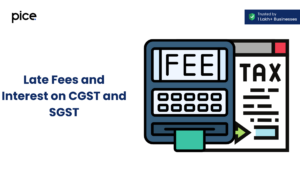Can GST be Charged on Discounted MRP?
- 21 Aug 24
- 18 mins

Can GST be Charged on Discounted MRP?
- History and Evolution of MRP
- Why MRP is needed?
- Why might MRP not be required?
- Impact of GST on MRP
- Whether MRP Will Increase or Decrease After GST?
- Valuation of GST on MRP Products
- Tools and Software for Accurate GST Valuation
- MRP Calculation
- What Can a Consumer Do if Retailers Charge More Than MRP?
- Conclusion
Key Takeaways
- MRP ensures consumer protection by capping the maximum price a retailer can charge.
- GST is applied to the discounted price, not the MRP, ensuring fair taxation.
- Post-sale discounts must meet specific criteria to avoid GST charges.
- Calculating MRP involves adding base price, additional costs, and GST.
- Consumers can report overcharging to consumer protection authorities if retailers exceed the MRP.
MRP stands for Maximum Retail Price. It's the highest price that can be charged for a product in a specific region. This ensures consumers are not overcharged.

History and Evolution of MRP
The concept of Maximum Retail Price (MRP) was introduced as a consumer protection measure to prevent retailers from overcharging customers. Initially, the idea was to establish a standardized price point for products across different regions, ensuring fairness and transparency in pricing.
Over time, the MRP system evolved in response to changing market dynamics, economic policies, and consumer behavior. With advancements in technology and the rise of e-commerce, the enforcement and calculation of MRP have become more sophisticated, incorporating various factors such as production costs, taxes, and market demand.
Despite these changes, the core objective of MRP—to protect consumers and maintain price consistency—remains intact.
Why MRP is needed?
Consumer Protection
- MRP, or Maximum Retail Price, is essential for protecting consumers from overcharging. By setting a cap on the price at which a product can be sold, MRP ensures that retailers cannot exploit consumers by inflating prices unfairly. This regulatory measure acts as a safeguard, ensuring that consumers are not taken advantage of and that they receive fair value for the goods they purchase.
Standardization of Prices
- MRP plays a crucial role in standardizing prices across different regions. Without MRP, the price of a product could vary significantly from one location to another, leading to confusion and potential unfairness. By mandating a maximum price, MRP helps maintain consistency, ensuring that consumers pay a uniform price regardless of where they make their purchase.
Legal Requirements
- In many jurisdictions, displaying the MRP on products is a legal requirement. This regulation adds an additional layer of consumer protection, as it mandates transparency in pricing. Retailers are legally bound to adhere to the MRP, and failure to comply can result in penalties. This legal framework helps enforce fair pricing practices and protects consumers from price gouging.
Market Stability
- MRP contributes to market stability by preventing runaway inflation of product prices. By capping prices, MRP helps keep goods affordable for the average consumer, promoting economic stability. This benefit extends to businesses as well, as predictable pricing can lead to more stable demand and better inventory management.
Promoting Fair Competition
- By enforcing a maximum retail price, MRP promotes fair competition among retailers. When all sellers are required to adhere to the same price cap, they must compete based on factors other than price, such as product quality, customer service, and brand reputation. This encourages innovation and improvement in the marketplace, benefiting consumers in the long run.
Consumer Awareness
- MRP also plays a vital role in increasing consumer awareness. By clearly displaying the maximum price on products, consumers can make informed purchasing decisions. This transparency helps build trust between consumers and retailers, fostering a more informed and empowered customer base.
Why might MRP not be required?

Market Competition
In a competitive market, the forces of supply and demand naturally regulate prices. Retailers strive to attract customers by offering the best value, leading to competitive pricing. This market-driven approach can make the Maximum Retail Price (MRP) unnecessary, as prices are kept in check by competition rather than regulatory caps.
Online Shopping Impact
- The rise of e-commerce has introduced dynamic pricing models, where prices fluctuate based on demand, time, and availability. Online platforms often offer additional discounts, special deals, and price comparisons that are not feasible with a fixed MRP. This flexibility can benefit consumers more than a static MRP, allowing for real-time adjustments and promotions.
Regional Price Variations
- Different regions may have varying costs associated with logistics, extra taxes, and market conditions. A single MRP might not account for these regional differences, leading to inefficiencies. For instance, transportation costs in remote areas can significantly impact the final price of a product, making a uniform MRP impractical and sometimes unfair to retailers in higher-cost regions.
Input Tax Credit and GST
- With the implementation of the Goods and Services Tax (GST) and the availability of Input Tax Credit (ITC), the cost structure of products has become more transparent. Businesses can claim credits for taxes paid on input services, reducing overall costs. This transparency and reduction in cascading taxes can lead to more competitive pricing, further diminishing the need for a regulated MRP.
Base Price and Price Increase Flexibility
- Businesses often need flexibility to adjust prices based on changes in input costs, such as raw materials and labor. The MRP system can limit this flexibility, making it difficult for businesses to respond to market conditions. Allowing businesses to set prices based on the base price and adjust for price increases as needed can lead to a more efficient and responsive market.
Advertisement Rule and Promotions
- Promotional strategies, such as cash discounts and sales, are crucial for driving consumer interest and clearing inventory. Strict adherence to MRP can restrict these marketing efforts, as discounts on cost cannot exceed the MRP. More flexible pricing policies can enable businesses to implement effective advertisement rules and promotions, benefiting both consumers and retailers.
Consumer Protection Council and Legal Framework
While the Consumer Protection Council and other legal frameworks ensure fair practices, they can also address issues of overpricing and unfair trade practices without relying solely on MRP. These bodies provide regulatory oversight that adapts to market changes, ensuring consumer rights are protected through a combination of regulations and market-driven solutions.
- MRP Rules After Changes in GST Rate and Its Enforcement
The Goods and Services Tax (GST) is a comprehensive, multi-stage, destination-based tax that replaced various indirect taxes. Its introduction aimed to create a unified tax structure, eliminate the cascading effect of taxes, and simplify the taxation process.
GST has significantly altered the pricing dynamics for consumer goods, impacting how the Maximum Retail Price (MRP) is calculated and displayed.
Impact of GST on MRP
The implementation of GST has had a profound impact on the actual price of products. Prior to GST, multiple indirect taxes, such as VAT, service tax, and excise duty, were included in the cost of goods.
With GST, these taxes were consolidated into a single tax, necessitating adjustments to the MRP to reflect the new tax structure accurately. The marked price of products, now inclusive of GST, provides a clearer picture of the final cost to consumers.
Calculation of MRP Post-GST
Post-GST, the calculation of MRP includes the base price, the applicable GST rate, and other associated costs such as transportation and handling. For instance, if a product's base price is Rs 100 and the GST rate is 18%, the MRP would be calculated as follows:
- MRP=Base Price + (Base Price × GST Rate)
- MRP=100+(100×0.18)= 118 MRP =100 + (100×0.18)=118
Enforcement of New Rules
To ensure compliance with the updated GST regulations, stringent enforcement measures have been put in place. Businesses are required to display the revised MRP inclusive of GST on all products.
Regulatory bodies conduct inspections and audits to ensure that retailers adhere to these new pricing norms. Non-compliance can result in penalties and legal action, ensuring that consumers are not overcharged.
Consumer Awareness and Transparency
A crucial aspect of enforcing the new MRP rules is ensuring consumer awareness and transparency. Consumers need to understand that the MRP now includes GST, which makes price comparisons easier and purchasing decisions more informed.
Public awareness campaigns and labeling requirements have been introduced to educate consumers about these changes.
Challenges in Implementation
The transition to GST posed several challenges for businesses, including recalculating and updating MRPs across thousands of products. Small and medium-sized enterprises (SMEs) faced particular difficulties due to limited resources and the complexity of compliance.
However, with the aid of accounting software and government support, most businesses have adapted to the new system.
Monitoring and Compliance
- Regulatory authorities closely monitor the enforcement of MRP rules under GST. Periodic audits and inspections help ensure that businesses comply with the pricing regulations. Consumers are encouraged to report discrepancies and overcharging, aiding in the enforcement process.
Consumer Protection and Legal Framework
- The Consumer Protection Council and other legal bodies ensure fair practices in the market. They address issues of overpricing and unfair trade practices, providing a regulatory oversight that adapts to market changes. These bodies ensure that consumer rights are protected through a combination of regulations and market-driven solutions.
Whether MRP Will Increase or Decrease After GST?
The introduction of the Goods and Services Tax (GST) has had a varied impact on the Maximum Retail Price (MRP) of products. Several factors influence whether the MRP will increase or decrease post-GST.
These factors include the rate of GST applied, the elimination of cascading taxes, changes in input costs, and the efficiency of the supply chain. By consolidating multiple indirect taxes into a single tax, GST aims to streamline the taxation process and potentially reduce overall tax burden, but the actual impact on MRP can vary.
- Elimination of Cascading Taxes
One of the primary benefits of GST is the elimination of cascading taxes, where tax is levied on top of another tax. This simplification can lead to a reduction in the overall tax burden on products. For example, previously, a product might have been subject to VAT, excise duty, and other state taxes, all compounding on each other. GST replaces these taxes with a single tax, which, in some cases, lowers the MRP.
- Changes in Input Costs and Input Tax Credit
The availability of Input Tax Credit (ITC) under GST allows businesses to claim credit for the taxes paid on inputs. This reduces the overall cost of production, which can lead to a decrease in MRP. For instance, a manufacturer can claim ITC on the GST paid for raw materials, reducing the production cost and, consequently, the final price of the product.
Impact on Different Sectors
The impact of GST on MRP varies across different sectors. For fast-moving consumer goods (FMCG), where products often have a lower tax rate under GST compared to the previous tax regime, there has been a noticeable decrease in MRP. Conversely, sectors with higher GST rates might experience an increase in MRP.
For example, the GST rate on luxury goods is higher, which could result in a higher MRP for such products.
- Examples
For instance, a study on consumer goods like soap and toothpaste might show a reduction in MRP due to lower tax rates under GST. On the other hand, electronic goods with higher GST rates might see an increase in MRP. These case studies highlight the sector-specific impacts of GST on pricing.
- Predictions and Trends
Experts predict that the overall trend will be a stabilization of MRPs as the market adjusts to the new tax regime. Initially, there might be fluctuations as businesses recalibrate their pricing strategies.
Over time, the benefits of a unified tax system, reduced compliance costs, and the elimination of cascading taxes are expected to lead to more competitive and fair pricing.
- Consumer Perception and Market Dynamics
Consumer perception plays a significant role in the impact of GST on MRP. Transparency in pricing and tax breakdowns can help consumers understand the changes in MRP.
Additionally, competitive market dynamics will drive businesses to adjust their prices to maintain market share, potentially leading to reduced MRPs for certain products.
Valuation of GST on MRP Products

The Goods and Services Tax (GST) has revolutionized the way taxes are calculated and applied to products in India. One of the critical aspects of this system is the valuation of GST on Maximum Retail Price (MRP) products.
Knowing how GST is calculated and applied to MRP ensures transparency and compliance with tax regulations.
- Components of MRP
Before diving into the GST valuation, it is essential to understand the components that make up the MRP of a product. The MRP includes the base price of the product, the profit margin for the manufacturer and retailer, transportation costs, and any other applicable costs. Under the GST regime, the tax is added to this total to determine the final price that consumers pay.
- Calculation Methods for GST on MRP
The valuation of GST on MRP products involves a straightforward calculation process. The GST is applied to the base price plus any additional costs, excluding the GST itself. For example, if the base price of a product is ₹100 and the GST rate is 18%, the calculation would be as follows:
- Total Cost (excluding GST)= Base Price + Additional Costs
- Total Cost=100+(Transportation Costs + Profit Margin)
- GST Amount=Total Cost × GST Rate
- Final Price (MRP)= Total Cost + GST Amount
For simplicity, assuming the additional costs amount to ₹20, the total cost would be ₹120. The GST amount would then be:
- GST Amount=120×0.18=21.60GST Amount=120×0.18=21.60
- Therefore, the final price (MRP) inclusive of GST would be:
- Final Price=120+21.60=141.60Final Price=120+21.60=141.60
Examples of GST Valuation
To illustrate further, let’s consider a few examples:
FMCG Products (Fast-Moving Consumer Goods)
- Base Price: ₹500
- Additional Costs: ₹100
- Total Cost: ₹600
- GST Rate: 12%
- GST Amount: ₹600 \times 0.12 = ₹72
- Final MRP: ₹600 + ₹72 = ₹672
Electronics
- Base Price: ₹10,000
- Additional Costs: ₹1,000
- Total Cost: ₹11,000
- GST Rate: 18%
- GST Amount: ₹11,000 \times 0.18 = ₹1,980
- Final MRP: ₹11,000 + ₹1,980 = ₹12,980
Challenges in GST Valuation
While the calculation itself may seem straightforward, businesses often face challenges in accurately determining the GST on MRP products. These challenges include:
- Fluctuating Costs: Costs such as transportation and raw materials can fluctuate, affecting the total cost and, consequently, the GST amount.
- Compliance: Ensuring compliance with constantly changing GST rates and regulations can be complex.
- System Updates: Businesses must regularly update their pricing systems and software to reflect the latest GST rules, which can be resource-intensive.
Tools and Software for Accurate GST Valuation
To address these challenges, various tools and software solutions are available to help businesses accurately calculate GST on MRP products. These tools can automate the calculation process, ensure compliance with the latest regulations, and simplify the updating of pricing systems.
Popular accounting software, such as Pice, offers modules specifically designed for GST compliance.
Consumer Awareness and Transparency
- Transparency in pricing is crucial for maintaining consumer trust. Businesses must ensure that the GST component is clearly indicated on product labels and invoices. This transparency helps consumers understand what they are paying for and fosters trust in the brand.
MRP Calculation
Calculating the Maximum Retail Price (MRP) involves several steps to ensure that all costs, taxes, and regulations are accurately accounted for. Here is a step-by-step guide to calculating MRP,
Step 1: Determine the Base Price
The base price is the initial cost of the product before any additional expenses or taxes are added. This includes the cost of raw materials, manufacturing, and other direct costs.
Example:
Base Price: ₹500
Step 2: Add Additional Costs
Additional costs include expenses such as transportation, handling, and packaging. These costs are added to the base price.
Example:
- Additional Costs (Transportation, Handling, and Packaging): ₹100
- Total Cost (excluding GST)= Base Price + Additional Costs
- Total Cost= 500 + 100= 600Total Cost = 500 + 100 = 600
Step 3: Calculate GST Amount
GST is calculated as a percentage of the total cost (excluding GST). The GST rate varies depending on the product category. The implementation of GST and the availability of Input Tax Credit (ITC) can impact the final calculation.
Example:
- GST Rate: 18%
- GST Amount=Total Cost × GST Rate
- Amount= 600 × 0.18 = 108 GST Amount = 600 × 0.18 = 108
Step 4: Add GST to the Total Cost
To determine the final MRP, add the GST amount to the total cost.
- Final MRP=Total Cost + GST Amount
- Final MRP=600+108=708
Step 5: Ensure Compliance with Legal Requirements
Make sure to print the MRP on the product packaging in accordance with legal requirements for consumer protection. This helps maintain transparency and ensures consumers are aware of the maximum price they should pay. Compliance with the Consumer Protection Council and other legal frameworks is crucial.
What Can a Consumer Do if Retailers Charge More Than MRP?

If a retailer charges more than the Maximum Retail Price (MRP) printed on a product, consumers have several options to address the issue. The MRP is the highest price that can be charged for a product, and charging more than this is a violation of consumer rights.
Here are the steps a consumer can take, along with relevant keywords for clarity:
- Verify the Price on the Product
Before taking any action, ensure that the price you were charged is indeed higher than the MRP printed on the product. The MRP includes all applicable taxes, such as GST (Goods and Services Tax), and any additional costs.
- Request a Clarification from the Retailer
Politely ask the retailer to explain why they have charged more than the MRP. Sometimes, the discrepancy could be due to an error in billing or miscommunication.
- Retain the Invoice
Keep the purchase invoice, as it serves as proof of the transaction. The invoice should detail the price charged, the MRP, and the GST applied. This document will be crucial if you need to escalate the complaint.
- Report to Consumer Protection Authorities
If the retailer does not rectify the overcharge, you can report the issue to consumer protection authorities. In India, this includes:
- Consumer Courts: Also known as Consumer Disputes Redressal Commissions, these courts handle complaints about unfair trade practices, including overcharging.
- Consumer Forum: Local consumer forums can provide immediate assistance and advice on how to proceed with your complaint.
- Consumer Laws and the Ministry: The Consumer Protection Act provides a framework for addressing such grievances.
- The Consumer Affairs Ministry also offers platforms for reporting complaints.
- File a Complaint with Consumer Helplines
Use national consumer helplines, such as the National Consumer Helpline (NCH) in India, which can guide you through the process of filing a complaint. They can also mediate between you and the retailer.
- Leverage Online Consumer Complaint Portals
Several online platforms allow consumers to file complaints against retailers for overcharging. These portals often provide a structured way to report issues and track the progress of your complaint.
- Social Media and Public Awareness
Sometimes, highlighting the issue on social media can expedite resolution. Many companies respond quickly to public complaints to protect their brand image. Ensure to tag the retailer and relevant consumer protection agencies in your posts.
- Legal Action
As a last resort, consider taking legal action against the retailer. Consulting with a legal expert who specializes in consumer protection laws can help you understand your rights and the best course of action.
List of Relevant Authorities and Actions
- Consumer Courts: Filing a case in the District Consumer Disputes Redressal Forum (DCDRF) for grievances.
- Consumer Forum: Seeking assistance from local consumer rights organizations for mediation.
- Consumer Laws: Utilizing the Consumer Protection Act to understand and assert your rights.
- Consumer Ministry: Reporting the issue to the Ministry of Consumer Affairs for intervention.
Conclusion
MRP and its implications are crucial for both consumers and businesses. The MRP system ensures that consumers are protected from overcharging and that prices remain standardized across regions. With the implementation of GST, the process of calculating and enforcing MRP has become more transparent and streamlined.
Consumers should be vigilant and aware of their rights, especially when discrepancies arise. Businesses, on the other hand, must ensure compliance with MRP and GST regulations to maintain trust and transparency.
💡Facing delays in GST payment? Get started with PICE today and streamline your GST payments. Click here to sign up and take the first step towards hassle-free GST management.
FAQs
What is MRP full form?
Is GST applicable to MRP or discounted price in India?
Is there GST on discounts given?
What is the formula for calculating MRP?
MRP=Base Price + Additional Costs + (Base Price + Additional Costs) × GST Rate
For example: MRP= ₹500+ ₹100 + (₹500 + ₹100)× 0.18 = ₹ 708
 By
By 
















